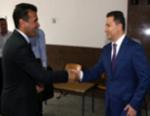 Nessuno o quasi, se si escludono gli addetti ai lavori e pochi altri appassionati, conosceva probabilmente il Sig. Higgs. Lui la sua teoria la elaborò nel 1964 con carta e penna. Il Bosone di Higgs era l’ultimo pezzo di un puzzle composto di 17 tessere, le 17 particelle fondamentali. Ora è stato trovato, anzi, confermato. Ma per trovarlo si è dovuto aspettare la fine della costruzione dell’acceleratore, il Large Hadron Collider presso il CERN di Ginevra , nel 2008 (anche se ha cominciato a fornire dati dal 2009).
Nessuno o quasi, se si escludono gli addetti ai lavori e pochi altri appassionati, conosceva probabilmente il Sig. Higgs. Lui la sua teoria la elaborò nel 1964 con carta e penna. Il Bosone di Higgs era l’ultimo pezzo di un puzzle composto di 17 tessere, le 17 particelle fondamentali. Ora è stato trovato, anzi, confermato. Ma per trovarlo si è dovuto aspettare la fine della costruzione dell’acceleratore, il Large Hadron Collider presso il CERN di Ginevra , nel 2008 (anche se ha cominciato a fornire dati dal 2009).E’ il 4 luglio, una data che evidentemente porta bene. Dalla dichiarazione di indipendenza degli Stati Uniti alla prima sonda atterrata su Marte. Oggi è stata annunciata l’esistenza del Bosone di Higgs e l’anziano scienziato era in prima fila a prendersi gli applausi (di molti di coloro che per anni hanno portato avanti la ricerca sulle sue teorie) che ha dovuto attendere per decenni, ma uno scienziato lo mette in conto. Uno scienziato spesso mette anche in conto che quel turbinio di mani che battono e generano onde sonore così gratificanti possa arrivare alla memoria, dopo la dipartita. In questo, in tutto questo c’è dell’eroismo, o almeno io ce lo vedo, in un mondo che ambisce al successo, al traguardo, alla vetta e alla gratificazione subito. E c’è dell’eroismo o forse solo della normalità (che è ancora più eccezionale) in coloro che hanno portato avanti la ricerca in questi anni, nonostante i problemi di fondi, nonostante molti di loro a tutt'oggi siano precari, si precari come molti di noi. E gli applausi vanno anche a loro.
Quell'attesa è servita, e il suo senso sta nel permettere un ulteriore balzo in avanti per la ricerca scientifica (dalla fisica alla medicina e chi più ne ha più ne metta). Un balzo la cui spinta verso l’alto è partita quasi cinquantanni or sono e che la gravità ha riportato con i piedi sulla terra solo oggi. Da teoria a certezza. Un salto in alto e pure in lungo, metà di una vita in cui altre generazioni di scienziati, spesso precari (ribadiamolo) hanno adottato il figlio teorico di Higgs e lo hanno portato in braccio fino ad oggi. Complimenti davvero.
Matteo Castellani Tarabini
@contepaz83
Congratulations, Mr. Higgs
Mr. Peter Higgs has waited for more than half his life for his theory to be validated. Because the scientific method requires the laboratory confirmation and then the counterproof confirmation and because you need money, the funds for research.
Nobody or almost, if you exclude the people who work on these topics or simple passionates, probably knew Mr. Higgs. He elaborated his theory in 1964 with pen and paper. Higgs' Boson was the last piece of a puzzle made of 17 pieces, the 17 fundamental particles. Now it has been found, or better, confirmed. But to find it we had to wait the end of the construction of the accelerator, the Large Hadron Collider at the CERN in Geneve in 2008 (even though it started giving results in 2009).
It's the 4th of July, a date that evidently is lucky. From the Indipendence of the United States to the first Mars explorer. Today the existence of the Higgs Boson has been confirmed and the old scientist was in the first row to take his applause (of many who for years have made research based on his theories), that he had to wait for decades, but a scientist takes that into account. A scientist also takes into account that the storm of hands clapping and generating such gratifying soundwaves might actually survive his demise. In this, in all of this there's a lot of heroism, or at least I see it, in a world that lusts for success, goals, the top and immediate gratification. And there is also heroism or just normality (which is even more exceptional) in those who have done research during all these years, in spite of the funds problems, despite many of them are still temporary workers, yes, temporary as all of us. And the applause goes to them as well.
This wait has been useful and its sense is in the great step forward that most probably will allow scientific research, from physics to medicine and all that stands in between, to come a little bit closer to all of us. A jump for which the push forward started almost fifty years ago and that gravity brought with the feet on the ground only today. From theory to fact. A jump up ad forward, half a life in which other generations of scientists, often temporary (let's remind it once more) have adopted Higgs' theoretical son and have carried him in their arms until today. Congratulations indeed.
Matteo Castellani Tarabini







